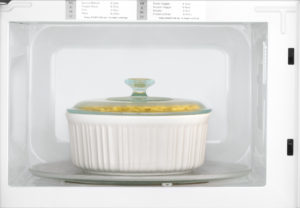For decades now, microwaves have become a fixture in our homes, offices, coffee rooms, cafeterias and dorm rooms, because there is nothing more convenient to use when heating frozen foods, make popcorn, heat up left overs or even reheat coffee. However, the question that always seems to come up is ‘are microwave ovens safe?’.
First, let’s look at how a microwave actually works; check out this video from How Stuff Works for the secret behind microwaves.
Now that we know how it works, let’s take a closer look at some of the common myths and misconceptions surrounding microwaves.
1. Microwaves Cause Cancer
Surely at one time or another we have all thought this, so here is the reality. Microwaves use radio frequency radiation (RF), which is at the low-energy end of the electromagnetic spectrum[1]. We are around this type of radiation every day whether we use the microwave or not. Cell phones are another example of a device that uses RF radiation. Yes, RF radiation is produced by microwave ovens, however; it is safely contained within the unit. According to the Canadian Cancer Society as long as the unit is used properly, in good working condition and you use proper containers within the unit, microwave ovens pose no threat.
[1] http://www.cancer.org/cancer/cancercauses/radiationexposureandcancer/radiofrequency-radiation
2. Microwaves are Radioactive
Microwaves are not radioactive; they actually use electromagnetic waves which are similar to those emitted from televisions, radio and electric shavers. The waves that are emitted excite water molecules which cause friction and then heat. So it is not possible that when microwaving your food it will make it radioactive.
 3. Microwaved Foods Are Dangerous
3. Microwaved Foods Are Dangerous
You need to ensure that you use microwave-safe containers in your microwave at all times. Microwave-safe containers do not contain lead, BPA or phthalates, where some plastic containers do. Please note that containers made with these chemicals are not that common, but just be aware.
Good Housekeeping tested 31 different containers; you can read their findings by clicking here. Just make sure that any container you use is marked clearly “microwave-safe”.
4. Microwaves Cook Food All the Way Through
Have you ever microwaved something where there are extreme hot spots and some other areas that are still frozen or cold? That is because microwaves tend to cook unevenly and from the outside in. The heat penetrates the food to a depth of 1 inch, and the rest relies of heat transfer. You are better off using your microwaves just to reheat or de-thaw and rely on the conventional oven to finish the job of cooking it entirely.
5. Microwaves Can Affect Pacemakers
In the past, certain models of pacemakers were affected by microwave ovens and would experience interference. According to Health Canada, “Improvements in the shielding and filtering of modern pacemakers and a reduction in the leakage levels from newer microwave ovens have reduced or eliminated these concerns. Most models today are not affected by being near a microwave oven, as long as the leakage is within the limits specified by Health Canada’s regulation. Anyone with a pacemaker who gets dizzy or experiences discomfort around a microwave oven should move away from the oven immediately and consult a health care professional.”
My advice is to ensure that your microwave oven is always in good working order and that you follow the operating procedures noted from the manufacturer. Just remember do not use your microwave if the door does not close, or it is bent, warped or damaged in any way. Make sure that if you do have any adjustments or repairs that it is done by a qualified service technician.
Isabelle Osmar, Your Appliances Expert

